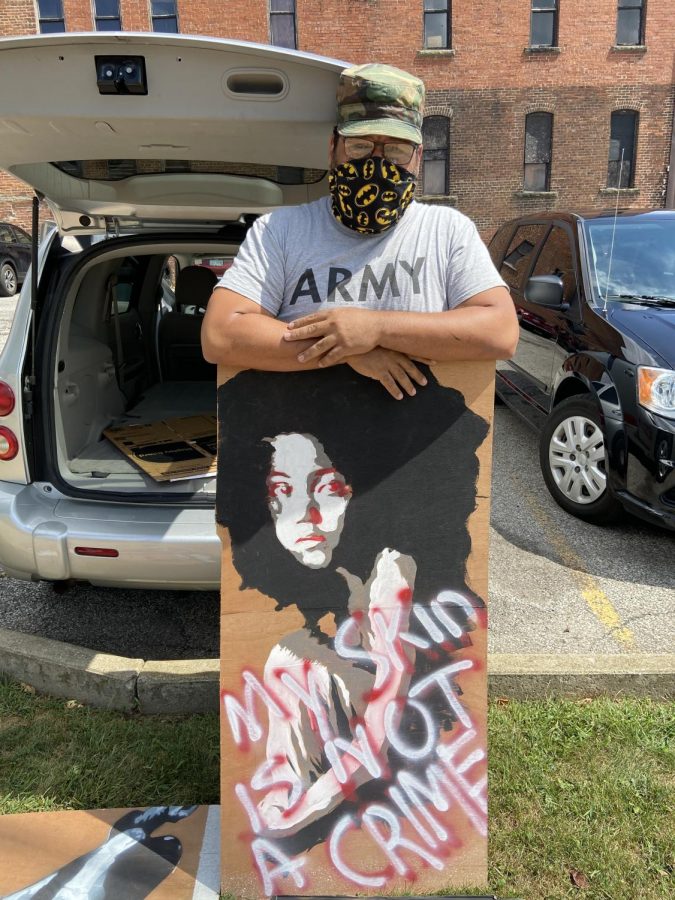92 days of continued protest in downtown Ashland
Ashland artist Rafael Serrano posing with one of his BLM pieces.
September 4, 2020
As the Black Lives Matter movement continues to grow across the nation, the Ashland community marked their 92nd day of continued protesting today at the intersection of Main Street and Claremont Avenue.
The protesting began informally by Keon Singleton on June 4, who took his first stand against police brutality throughout downtown Ashland.
Equipped with a sign that read, “if you were my color, who would you want to raise kids in the system we live in today?” Singleton jogged up and down Main Street shouting his message.
“I was expecting people to ignore me,” Singleton said. “I knew there was a lot of racism in town and it’s super small, so I really wasn’t expecting people to tag along.”
Singleton was wrong.
Three people joined him in the rain that day, and on that first weekend, 100 people gathered with him on the side of the road.
The protests in Ashland began 10 days after Minneapolis man George Floyd lost his life after a police officer kneeled on his neck for nearly nine minutes. Floyd’s death prompted protests across the country and the world; Ashland was no different.
“I was sitting by the light and some kid ran beside my car and screamed ‘Black Lives Matter,’” Ashland protestor Heather Sample said. “I thought sure they do, so I went down the street and came back up, and almost every day since then I’ve been here protesting.”
According to Sample, the protesters get a lot of hostility day-to-day from passing motorists. She says that one driver in particular passes almost every day yelling offensive rhetoric.
“I can’t go every single day anymore because I have my own personal life and have kids, but even when I’m not there, there’s people there every day,” Singleton said. “We want to get as many people in town aware of what we’re trying to do as possible because a lot of people either don’t understand our message, or are very antagonistic towards it.”
According to the 2010 U.S. Census, less than 2% of Ashland’s approximately 20,000 residents and less than 1% of Ashland County’s approximately 50,000 residents are African American.
“Being a part of the less than 1% Hispanic communities in this town, I am aware of the bubble this town lives in,” Ashland protestor Rafael Serrano said. “They don’t think they have a problem because well, they barely see any minorities. We are here and we’ve been living here. We are a face. We are humans.”
Serrano regularly attends the protests with his Black Lives Matter centric artwork that he puts on display.
Amid the growing BLM protests across Ashland and the country, an Instagram page run by an anonymous user named “Dear Ashland” has surfaces. It addresses different forms of discrimination and social issues that take place at AU by displaying anonymous submissions from the campus community.

Dear Ashland’s first post on July 1 reads: “As students of color at a Predominantly White Institution (PWI), it can be difficult and disheartening to exist in a space that does not always make room for us to show up authentically. The university has not done enough to protect and value its students of color. Now it is time for our voices to be heard, to be elevated, and to be used for change. We encourage you to share your stories about prejudices you have encountered at Ashland (racism, homophobie, etc.). Let you truths be heard.”
The account has amassed 642 followers since its creation, most of them AU students.
The account’s submissions have covered a wide range of issues including racism, sexism, homophobia, islamaphobia, sexual assault, harassment, cultural bias and others.
“It’s good that there’s people coming forth and we need more and more exposure to this stuff so that it’s realized as a real issue,” Singleton said. “This is a small predominantly white campus, but I was a student at Kent State and Malone – much larger universities, and they had the same issues. That’s why these movements are so important. You see these issues all over the country.”
Singleton believes that there is a simple solution to discriminatory issues on campus and across the globe.
“In short, love thy neighbor and avoid judgement,” he said. “It’s just like the golden rule but we aren’t following that in this day and age. ‘Treat others just how you want to be treated.’”



